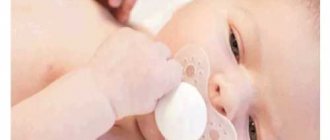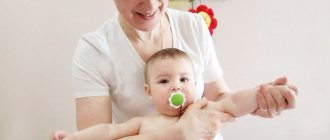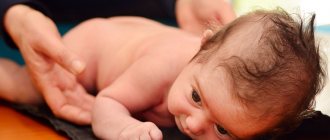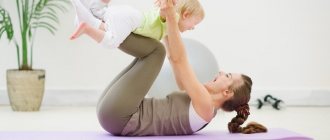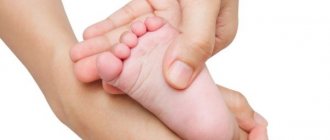The benefits of massage for a newborn
A properly performed massage for a newborn brings benefits, namely:
- strengthening muscles and joints;
- assistance in the formation of immunity;
- prevention of constipation, flatulence, colic;
- strengthening the musculoskeletal system;
- activation of metabolism;
- elimination of hypertension;
- stimulation of the passage of gases;
- sound sleep and good appetite;
- development of motor skills, coordination of movements and vestibular apparatus.
In newborns, the visual and auditory organs of perception are still at the stage of formation and development, but the skin analyzer develops much faster. Therefore, influencing the baby’s body through massage has a positive effect. Massage helps conduct impulses along the nerve endings to the cerebral cortex. This has a positive effect on the nervous system, which is responsible for the functioning of all organs and systems.
During the massage, tactile contact occurs between the newborn and the mother, which has a beneficial effect on the emotional state of the child. During the massage, the mother talks to the child, this also contributes to some privacy and reunification of mother and child.
After a massage session, the newborn’s lymphatic and circulatory systems are stimulated, and tissue and muscle nutrition is improved.
General rules for massage
Despite the fact that massage has a lot of positive effects, it is better to start these procedures from one and a half months and after consulting a specialist. But with the approval of the pediatrician, massage can be started from the first weeks of life, the main thing is to do it carefully.
Consultation with a pediatrician is fundamentally important, since not all children are allowed massage. The doctor will give the right recommendations so that the massage has a positive effect.
And, nevertheless, there are general rules without which massage for newborns is not complete.
The younger the child, the more careful the movements should be, since it is very easy to damage the skin, muscle or joint;
- the first sessions should last no more than 1-2 minutes, the time should be increased gradually, and it is important to monitor the child’s reaction;
- It is better to carry out massage on a hard surface, for example, on a changing table, which needs to be covered with a sheet or diaper;
- ventilate the room so that the air is fresh and relaxing, but the room must be warm enough, since the baby will have to be undressed;
- hands must be clean and warm, without long nails, rings or other jewelry;
- for smoother and softer movements, use baby cream or baby oil;
- if during the procedure the baby cries and tries to turn away from your hands, the procedure must be stopped (the child may be in pain or have some problems);
- During the massage, eye contact is necessary, it is worth talking to the child (this promotes a trusting relationship, and the child will love massage sessions);
- always start with stroking and very light rubbing;
- You cannot massage immediately after eating; you must wait an hour and a half after feeding; refrain from massage immediately after the baby wakes up;
- For children under three months of age, it is not recommended to massage the inner thighs, armpits, popliteal fossae, kneecaps and elbows. Try to avoid any contact with the newborn's fontanel.
The main rules of massage for infants
If you attach your baby to the breast correctly, the likelihood of him swallowing air while sucking will be significantly reduced. Please note:
- Do not massage if the child has a fever, signs of acute respiratory viral infection, bronchitis, vomiting, diarrhea or skin problems (if it is a fungus, it can spread to new areas of the body).
- Your hands should be warm, the movements should be very gentle and calm (to avoid unnecessary friction, use powder, not oil), the massage therapist, be it mom or dad, should be in a good mood.
- A restorative massage for babies includes four techniques: stroking, rubbing, kneading and patting. But massage for colic is based on stroking.
- You need to do an anti-colic massage before each feeding for 5-7 minutes.
Types of massage, how to do it correctly
Types of massage:
- Hand massage.
- Foot massage. It is recommended to perform massage movements in the direction from the feet to the groin area.
- Tummy massage. This is the main type of massage, which plays an important role in the child’s well-being, it stimulates normal digestion and improves mood.
- Back massage. It is more suitable for babies from three months old than for babies of the first months.
- Face massage. It helps to relax the facial muscles, movements are light and neat.
Tummy massage.
The child must be laid on his back, warm hands placed on his stomach and held in this position for several minutes. This action helps the child relax. Next, perform light circular movements clockwise, without touching the ribs and groin area. An effective movement for passing gas is to flex the baby's legs toward the tummy. It’s important not to overdo it, just lightly press on your tummy with your feet.
Face massage.
A few steps are enough:
- gentle pinching movements with your fingertips in the cheek area;
- massaging - from the bridge of the nose to the temples;
- stretching - from the chin fossa to the corners of the mouth;
- light rubbing movements over the ears.
Back massage.
The child needs to be turned onto his stomach and begin stroking movements up and down. Next, we repeat the same movements from the spine to the lateral surfaces, moving to circular movements, to the left and right of the spine. We don't touch the spine. The next stage is the transition to the shoulders with the same movements. Light patting movements and pinching are acceptable. It is better to finish the massage with the same strokes with which we started.
Hand massage.
Start by working on your hands, gently knead each finger, this helps develop fine motor skills. Move in a circular motion onto your palm, then onto your wrist. Stroke the area of the forearm and shoulder, you can take the baby in your arms and make passive circular movements with them.
Foot massage.
First, stretch your feet and toes, then move on to your shins. Remember to avoid the knee area and inner thigh. You can make several passive circular movements, as is the case with your arms.
No matter what area you massage, in any case, avoid sudden movements that could injure the child.
Massage for newborns. 12 methods, or how to counteract colic
The baby’s digestive system is very vulnerable - it is just “learning” to function independently. Therefore, in the vast majority of cases, colic is a natural phenomenon that does not require special medical intervention. However, it is entirely in your hands to alleviate the child’s condition.
Step 1
The first time a newborn is put to the breast is always quite difficult. To stimulate the baby before feeding or directly during feeding, massage the baby's back from top to bottom through the clothes with the whole palm.
Then lightly move along the edge of the ear with the tips of two fingers and lightly rub the edge of the mouth. Such actions excite the sucking reflex. During feeding, lightly touch the ear and lower jaw, making stroking movements. This will keep your baby awake and encourage him to suck more vigorously.
To minimize the “chaotic” movements of the arms with which the baby pushes away the breast, trying to put his fist in his mouth, gently place one arm under the breast, and gently hold the other. This position will have a calming effect on the child. However, if the child is active and does not respond to your actions, do not use force. Better try next time.
Step 2
A newborn baby is too sensitive, so limit yourself to a minimum of movements. Your warm hands placed on your tummy for a few minutes will start the processes by stimulating two important organs for digestion - the liver and gall bladder - big lovers of heat.
Step 3
Now we will make the well-known “bicycle”. Only your movements should be smooth and careful. We bend and unbend the baby’s legs one by one. Children usually enjoy these games, but if the baby resists and starts crying, change the pace to a slower one and act more gently. If the protest continues, postpone the lesson until next time.
Step 4
Panther on a tree pose can help relieve cramps. So, we place the baby’s head to the elbow, holding the butt and stroking the back. This position of the body, together with physical contact, normalizes the digestive process.
Step 5
This is probably the very first step and a very simple solution that is either ignored or forgotten about. Infants have abdominal breathing, which is the main natural massage for the digestive tract. A tight diaper creates an obstacle to this process, prevents the legs from bending, which disrupts the natural processes in the intestines. Try not to pull the diaper too tight, and for the same reason, in the future, watch the belt on your clothes - it should not be too tight.
Step 6
The legs, pressed against the tummy, create pressure on the intestines, which improves and speeds up the digestive process. Turn your baby to face you, bend his knees as high as possible and press him to your stomach. Holding the baby's back with one hand and the other under the legs, gently stroke the lower part of the back with your palm in a circular motion.
Step 7
For babies 2–4 months old, the following massage methods can be used.
To speed up and facilitate the work of the digestive organs (contraindicated only in cases of pronounced diarrhea!), we do the same as for newborns. It is only important to remember that in one “session” you should not use more than two different exercises and types of massage, otherwise you only risk harming the baby instead of helping.
Step 8
Abdominal massage with rotation
The baby lies on his back directly in front of you, bend his legs a little and turn him slightly to the right.
We move our hand diagonally from the top of the back to the bottom of the tummy, starting from the right side. With one hand you hold your knees, and with the other we make massage movements at waist level on the left side.
We return the baby’s body to the “soldier” pose and make general stroking movements, starting from the chest and ending with the toes, circling the pelvis.
Then we repeat the turns, but in the other direction - knees to the left of ourselves, stroking the right side. And then we return it to the upright position again, stroking the entire body.
Step 9
Gut in focus
With the tips of two fingers, with both hands, barely touching the skin, we “follow” the intestines. We start in the lower left part, gradually moving up. Under the ribs we “turn” from left to right, going across and going down along the descending part of the intestine.
Step 10
And again the familiar “bicycle”. With older children, you can play this game more actively, but provided that this does not cause protest. With smooth movements, we stretch one leg forward, pressing the second one to the stomach, alternately changing the position of the legs. We move slowly, without effort.
Step 11
Massage on a mattress (or other surface suitable for massage) - the child lies on his back facing you, we “fold” the legs on his stomach into a ball and lightly rock the baby left and right.
Step 12
A 4-month-old baby who confidently holds his head can be placed in the “Buddha” pose. With your back to you, bending his feet with your hands under his tummy. Make light swings to the right and left with your child.

